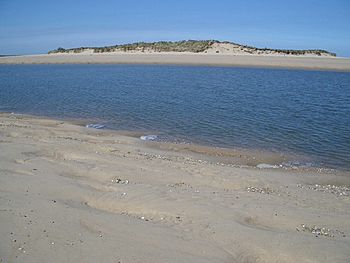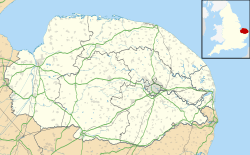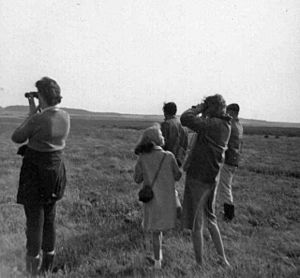Scolt Head Island facts for kids

From Gun Hill
|
|
| Geography | |
|---|---|
| Coordinates | 52°58′56″N 0°42′24″E / 52.9822°N 0.7066°E |
| Administration | |
|
England
|
|
| Region | Norfolk |
| County | King's Lynn and West Norfolk |
Scolt Head Island is a special barrier island located off the coast of north Norfolk, England. It sits between the towns of Brancaster and Wells-next-the-Sea. You can reach it by a ferry that runs during certain times of the year from a village called Overy Staithe.
This island is made up of shingle (small, rounded stones) and sand. It seems to have formed from a long strip of land that once stuck out from the coast. Over time, ocean currents and waves have slowly moved it westwards and closer to the shore.
Scolt Head Island is home to many different habitats. These include sand dunes, salt marshes, and wide areas of sand and mud flats that are covered and uncovered by the tide. It's a very important place for birds. Many Sandwich and little terns come here to breed. You can also find lots of common and Arctic terns. In winter, many waders (birds that wade in shallow water) and wildfowl (like ducks and geese) visit the island. Some rare plants also grow here, as they are specially adapted to the tough environment.
The National Trust bought the island in 1923 to protect it. It then became a national nature reserve. Later, it became part of a larger protected area called the North Norfolk Coast SSSI. Today, it has even more protection under international agreements like Natura 2000 and Ramsar. It is also part of the beautiful Norfolk Coast Area of Outstanding Natural Beauty. The first person to live and work as a "watcher" (or warden) on Scolt Head was Emma Turner, a famous bird expert and photographer.
This quiet island has mostly been left alone by people. However, it was used as a practice area for artillery during World War II. Scolt Head Island is very important for science. For almost a hundred years, scientists have studied its geomorphology, which is how the land forms and changes.
Contents
About Scolt Head Island
Scolt Head Island is about 6.5 kilometers (4 miles) long. It's a long strip of shingle and sand along the Norfolk coast. Even though it's called an "island," you can sometimes walk across the mudflats to it when the tide is low. However, this path can be dangerous because the mud can be deep and the tides change quickly. So, it is not recommended to walk there.
The main part of the island has a beach and a ridge of sand dunes that run from east to west. It also has curved "hooks" of shingle that point south and east towards the land. The island covers about 737 hectares (1820 acres). It is mostly made of flint pebbles, which are smooth from being rolled by waves, and sand. Less than one percent of the island is made of other minerals.
The island is slowly growing westward. This happens because of waves and something called longshore drift. Longshore drift is when waves push sand and shingle along the coastline. The curved shingle ridges you see were once the western end of the island. As the island moved, new ridges formed. Salt marshes have grown in the areas between these old ridges.
Scientists say that the shingle areas here are very important for studying how the Earth's surface changes. They are some of the most studied places in the world. The salt marshes and shingle structures together are also very important for understanding the recent geological history of this coast. The salt marshes grow quickly, getting about 1 centimeter (0.4 inches) taller each year. They also develop a network of small channels as they get older.
You can take a ferry to the island from Burnham Overy Staithe. The ferry runs from April to September. Once on the island, there is a 1 kilometer (1,100 yard) nature trail with information boards. These boards help you learn about the island's wildlife and features.
Island History
Norfolk has a very long history of people living there. This goes back to the Paleolithic (Old Stone Age) period. Both modern humans and Neanderthals lived in the area many thousands of years ago. As the ice from the last Ice Age melted, the sea level rose. This filled what is now the North Sea. Many ancient sites from that time are now underwater in an area called Doggerland.
Early stone tools found nearby show that people were in this area even when the sea was much further away. Other tools from different stone ages have also been found. Layers of peat (partially decayed plant matter) found between sea sediments show that the sea once moved away, making this area dry land around 1980–1780 BC.
Signs of human activity on the island itself include old pottery and building foundations from after World War II. There are also wooden structures in the marshes. These include posts for mussel farming and a wooden structure that was likely a fish trap.
It was once thought that Scolt Head Island formed from a shingle ridge offshore. This would mean it was always an island. However, now scientists believe it was originally a long strip of land connected to the Holkham dunes. An old map from 1585 seems to show a land strip here. Also, a list of local lands from 1630 did not mention the island as a separate place.
In 1923, the Earl of Leicester sold most of the island to the National Trust. They bought it for £500 to manage it as a nature reserve. The island was used as an artillery range during World War II. The SS Vina, an old cargo ship, was anchored near the island in 1944. It was used as a target for the RAF. You can still see its wreck at low tide. Parts of a Blenheim bomber plane were also found on the island in 2004.
In 1953, the Nature Conservancy Council took over managing Scolt Head Island. It officially became a national nature reserve in 1967.
Animals and Plants
Birds and Their Reproduction
Scolt Head Island is a very important place for birds. Many Sandwich and little terns come here to breed and raise their young. You can also find common and Arctic terns nesting here. The marshes are a winter home for many wildfowl and waders. These include shelduck, wigeon, teal, and curlew.
Brent geese eat plants like sea lettuce and eelgrass found here. The island is also a major stop for pink-footed geese. Over 22,000 of these geese visited in some winters, which is a huge number.
Because of its location, many migrant birds pass through the island. Sometimes, huge numbers of birds can be seen when the weather is right. Very rare birds, called vagrants, sometimes show up too. Examples include an isabelline shrike in 2003 and a dusky warbler in 2000.
Other Animals
The island used to have a very large rabbit population. In 1954, a disease called myxomatosis killed most of them. However, their numbers have gone up and down since then. Other mammals living on the island include stoats, different kinds of shrews, wood mice, and short-tailed voles. Sometimes, different types of deer even cross the marshes to reach the island.
You can also find interesting insects here. One is the intertidal ground beetle Dicheirotrichus gustavi. It comes out at night to feed on the salt marshes. Another beetle, Bledius spectabilis, is very unusual. It actively protects its larvae (young) from a parasitic wasp and from the Dicheirotrichus gustavi beetle.
Plants of the Island
Both the salt marsh and the sand dunes on Scolt Head Island have a wide variety of plants. Many of these plants are uncommon. In the most exposed parts of the salt marsh, you'll find glassworts and common cord grass. As the marsh grows older, other plants appear. These include sea aster, sea lavender, and sea purslane. You can also see sea plantain and other common marsh plants.
The shingle ridges are home to plants like biting stonecrop, sea campion, and yellow horned poppy. Other plants found here are sea thrift, bird's foot trefoil, and sea beet. Rare species like matted sea lavender and sea heath also grow in this habitat.
The sand dunes are first held in place by plants like marram grass and sea couch grass. These plants help other species to grow, such as sea poa grass and sand couch-grass. Other plants that thrive in this dry, sandy environment include sea holly, sand sedge, and pyramidal orchid.
Visiting and Protecting the Island
Many people enjoy visiting the north Norfolk coast for outdoor activities. A survey in 2005 found that 39% of visitors came mainly for birdwatching. Millions of visitors come to the area each year. This brings a lot of money to the local economy and creates many jobs.
However, a lot of visitors can sometimes cause problems for wildlife. Birds that nest in open areas, like ringed plovers and little terns, can be disturbed. Wintering geese can also be affected. Plants can be trampled, which is a big issue in sensitive places like sand dunes and shingle areas with plants.
Scolt Head Island is not easily accessible, which helps protect it from too many visitors. Conservation groups work together to manage the coast. They divide the area into zones based on how sensitive the habitats are and how much tourism they get. Other similar dune systems nearby are very sensitive and have a lot of visitors. Scolt Head Island is considered to have fragile habitats but less tourism pressure. This means it needs careful management to keep it special.
Threats to the Island
Scolt Head Island faces challenges from powerful storms. In 1931–33, storms washed away 250 meters (250 yards) of the island. A big storm in 1938 and the North Sea flood of January 1953 also broke through the island. This caused shingle to be washed into the marshes behind it. After the 1953 flood, a fence was built. This fence helped to trap sand and allowed the broken part of the island to heal within a few months.
Images for kids





